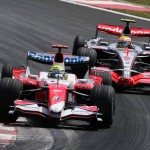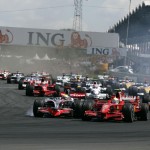ReLogically, if you’re into one branch of motor sport then you should like them all. I watched speedway through many a long year, thick and, mostly, thin, though even that wearies me now. But F1? That has never been a sport I watched with any interest, though at the time I was 13 Jackie Stewart was a big name and earned many plaudits.
It also seemed like barely a week went by in the season without some brave driver being killed in a high-speed crash, which lent F1 an air of permanent tragedy. At least the safety has improved, both through the design of the cars and the speed with which stewards and well-equipped medical staff get to the injured. But even so, there is probably at least a tiny proportion of the audience falling into the category of “ghoulish”, though true disciples would frown at the very thought.
So what’s the issue with F1, the most monied of all motorsports? Like football, the money may well be part of the problem: everyone wants a piece of the action, and in the rush for cash the true sport at the heart of it suffers. At the centre of it all, pulling the strings and earning the billions, is Bernie Ecclestone. Nothing happens without his say so, but whether he acts in the best interests of the sport or the best interests of Bernie Ecclestone you will have to decide for yourself.
However, what we do have is a constantly changing ruleset, so cars are forcibly redesigned at huge cost every year, and each time the teams find ways to outwit the regulators, meaning further rule changes follow in a never-ending cycle. This of course is the only real means the rule makers have to stop the richer teams forging yet further ahead, though seldom if ever is that goal ever achieved for long, if at all, and if it is then the big teams grumble.
After all, this is a sport where there are two main variables: drivers and manufacturers. Both have championships, but since the big sponsorship money and, therefore, the fastest drivers, go to the biggest teams with the biggest engine and aerodynamic development budgets, it’s no surprise that the fastest drivers end up in the fastest cars. More than this, great play is made of the practices, whereby teams compete for top spots on the grid for the actual race, which almost invariably go to the fastest drivers in the fastest cars. And guess what? The fastest drivers driving the fastest cars from the front of the grid almost always win!!! If ever there were a self-fulfilling prophecy in sport, this is it.
Ah, but there are other variables. Mechanical or tyre failure, accidents and other mishaps, though strangely these seem to occur rather less often to the best drivers in the best cars etc., and in spite of the beliefs of the purists, these accidents are where the cameras love to linger.
Meanwhile, said drivers/cars are usually in a procession out front, weaving their way through the tail-enders, who are supposed to and sometimes actually do make way. In fact, there is precious little genuine overtaking in F1, so the rule makers thoughtfully reintroduced pit stops in the vain hope that it would add interest to funereal racing. There is the overtaking – team A takes longer to refuel and put tyres on than team B, so team B’s driver overtakes team A’s best man, and so on. Do they adopt a 2-stop or a 3-stop strategy, intone the commentators with feigned gravity. My stances is simple: if you have to worry about pitstops to make a sport sound interesting, that sport is truly dull as ditchwater.
Ah, but there is still the noise, colour and spectacle. Maybe that is what attracts spectators by the thousand? Surely there can’t be there for the racing… So here are my suggestions to make F1 more watchable… and watch how F1 ignores these ideas totally!!
- Like stock cars, drivers are awarded a status – white for novice, yellow for inexperienced, blue for mid-ranking, and red for the creme de la creme. They can carry on qualifying, but the fastest drivers are always at the back of the grid, regardless of the car they are driving. They have no choice but to overtake!
- Before each race, a draw is made to allocate drivers to cars. Luck of the draw!
- As above but drivers are have to drive each car at least twice during the season, and can choose which races they pick the fastest or slowest cars.
- Qualification is banned altogether and drivers are handicapped according to their position in the championship.
- All drivers drive the same car. No, wait a sec, that’s Moto GP!!
Don’t hold your breath…
PS. This fiasco about tyres illustrates precisely what I mean about the artifice of F1 racing. Left to its own devices it would be deadly dull with virtually no overtaking, so Ecclestone fixes it so drivers are left with short-lived tyres that could explode at any time.
“F1 boss Bernie Ecclestone has for several years asked Pirelli to manufacture tyres with a deliberately limited life in order to promote more exciting races.Yet tyre blow-outs for both Nico Rosberg and Sebastian Vettel at the recent Belgian Grand Prix prompted several drivers to strongly criticise Pirelli’s approach. The issue will be debated by Ecclestone, team bosses, Pirelli management and drivers as part of ongoing talks about plans for faster cars in 2017.”
PPS. Jean Todt: FIA president says F1 is too expensive and complicated
http://www.bbc.co.uk/sport/formula1/39396820





If only they would listen to your suggestions x
Sincerely I don´t like F1 since my childhood. It´s completely boring, I prefer bicycle race.